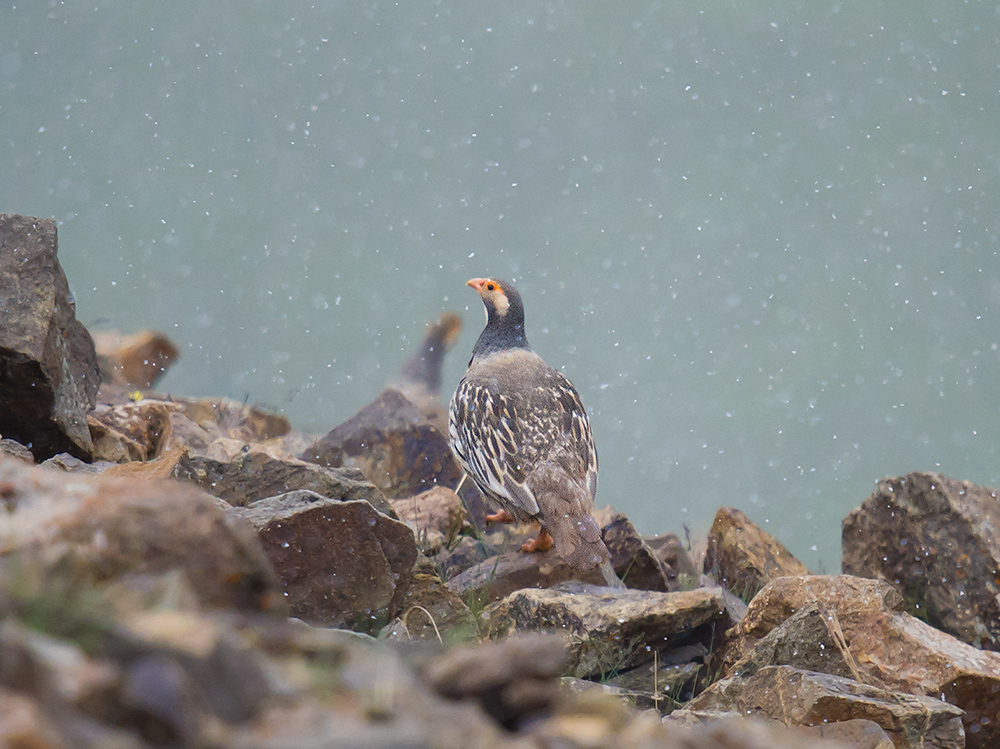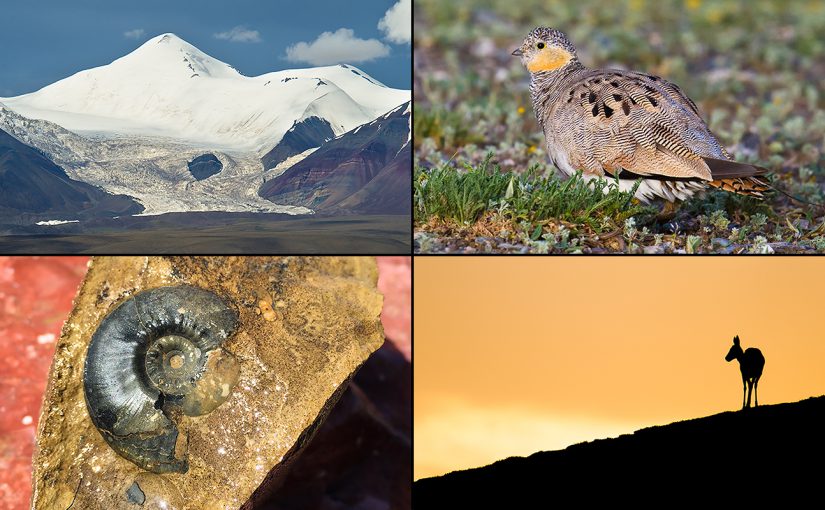by Craig Brelsford
Founder, shanghaibirding.com
INTRODUCTION
The featured image above shows some of the highlights of Hala Lake. Clockwise from top left: glacier and mountain, Tibetan Sandgrouse, Tibetan Gazelle at sunset, and sea mollusk 50 million years old.
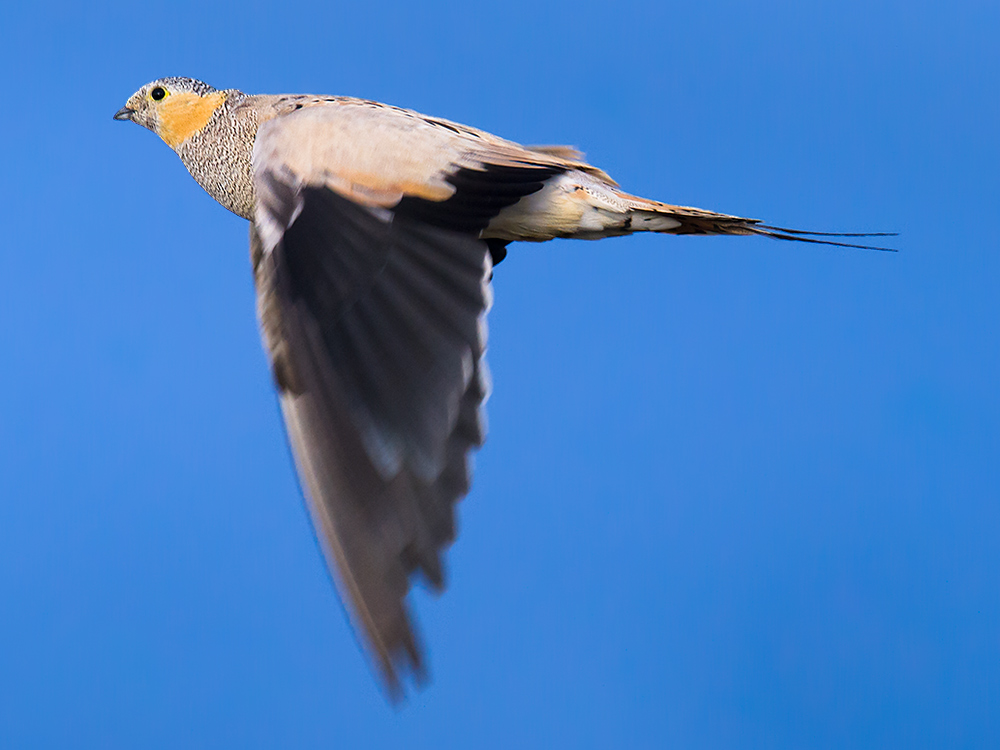
This page covers the seventh week of our eight-week birding trip to Qinghai, from Sat. 6 Aug. through Sat. 13 Aug. Elaine and I spent that time around Hala Lake, the wild, remote, high-altitude inland sea in north-central Qinghai. With the desolate environment as our backdrop, and despite daily rain, we noted 53 bird species. Highlights:
• Discovering flocks of Tibetan Sandgrouse in perfect semi-desert habitat near Hala Lake
• Finding 7 Tibetan Snowcock in a gorge east of the lake
• On the shore of Hala Lake, attaining several interesting Qinghai records, among them Little Stint, Ruddy Turnstone, Curlew Sandpiper, Grey Plover, Common Greenshank, and Eurasian Whimbrel
• Making various less-surprising records around Hala, among them Black Stork, breeding Lesser Sand Plover (our most numerous bird), Ruddy Shelduck, Common Shelduck, Common Merganser, Bar-headed Goose, and Pied Avocet
• Watching a Tibetan Fox dig up and devour a Plateau Pika, and surmising that the area, if explored thoroughly, would yield Snow Leopard, Tibetan Wolf, Tibetan Lynx, and other powerful mammals
• Witnessing landscapes unlike any I have seen in nine years in China, with the vast, silent steppe giving way to the azure inland sea, and snow-clad peaks and glaciated mountainsides brooding in the background
• While lamenting the damage overgrazing is doing even to an area as pristine as Hala Lake, befriending Tibetan and Mongolian herdsmen, sharing stories with them, and learning about their tough, interesting lives
• Despite being alone and having only a 2WD vehicle (Kia Sportage), despite having to make approximately two dozen tricky creek crossings, and despite a ban on foreigners at parts of Hala Lake (see note below), getting into and out of the area without incident
Note: Part of the area around Hala Lake is off-limits to foreigners, a fact of which Elaine and I were unaware during our visit. Foreigners are banned from Delingha County, an administrative area that includes much of the area south and west of Hala Lake as well as the entire lake itself. Foreigners are allowed in Tianjun County, which covers the area north and east of the lake, up to the shoreline.
Foreigners caught in Delingha County can expect harassment and even detention, as was the case with German bicyclist Andreas Bruder, whom Elaine and I met at Hala. After we separated, Andreas was arrested, detained, questioned, and transported back to Hedong-Hexi, the urban part of Delingha. A memory card of his was confiscated. Birders, with their binoculars, scopes, and cameras, presumably would endure even closer scrutiny than Andreas.
As long as this harsh policy remains in place, I advise foreigners to approach Hala Lake from the east, as Elaine and I did, and remain in the areas in Tianjun County. Drive a high-clearance, 4WD vehicle, as the route through Tianjun County is longer and remoter and involves more creek crossings than the road from Hedong-Hexi.
THE ROAD TO HALA
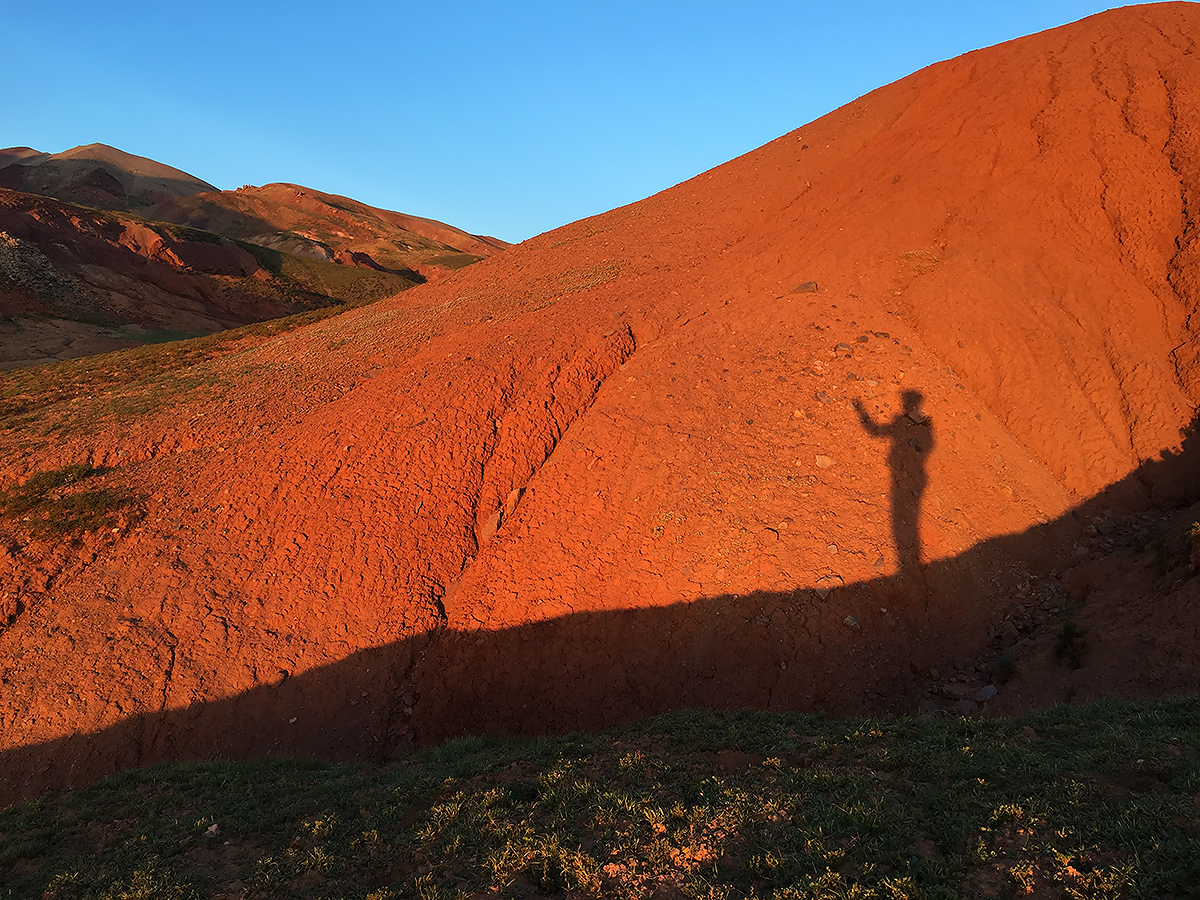
Our explorations of the Hala Lake area began on Sat. 6 Aug. Elaine and I were sitting in a restaurant in Yanglong Xiang (38.816483, 98.415873), a town in Haibei Prefecture. Laoban said, “Yes, your car can make it to Hala Lake.” We were on our way.
We got gas at the only station in Yanglong, on the west side of town. Right next to the station (38.814444, 98.411556) is the turnoff from the S204 to the Suli-Yanglong road. Driving our rented Kia Sportage, we took that road over the South Tuole Mountains, which separate the Heihe River Valley from the Shule River Valley. We noted Tibetan Fox and Tibetan Gazelle, and the next morning, Sun. 7 Aug., we found a flock of 35 Blue Sheep.
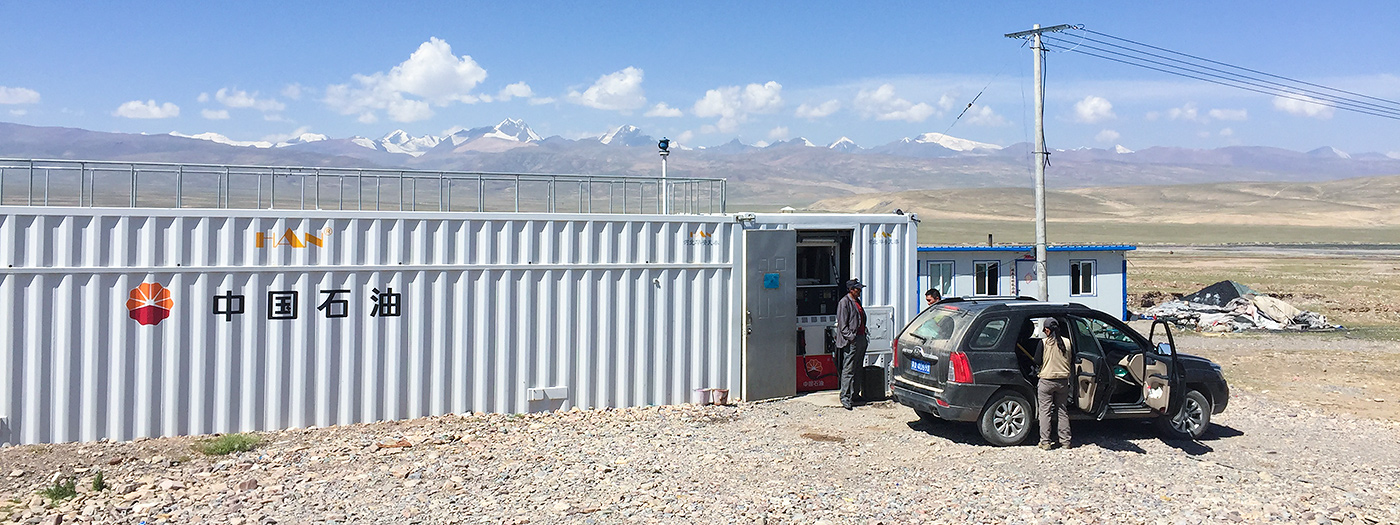
We drove to Suli (38.702633, 98.026018), a remote, dusty Tibetan town that evoked the American Wild West. At the only gas station in the valley, we met the “sheriff,” Mr. Zhou, a muscular and square-jawed Tibetan man who is the local law-enforcement officer and who knows the name of everyone in Suli. After I gave him views through our spotting scope, Sheriff Zhou invited us to his home to view his fossil collection. In his driveway, Elaine and I gazed at fossilized sea mollusks at least 50 million years old.
We walked into Mr. Zhou’s home, on a wall of which hung a portrait of Xi Jinping, and in a corner of which sat his mother, 85 and in good health. She barely acknowledged us, being immersed in prayer. Her giant prayer top, longer than a broom, spun constantly, and she never stopped shuffling her beads.
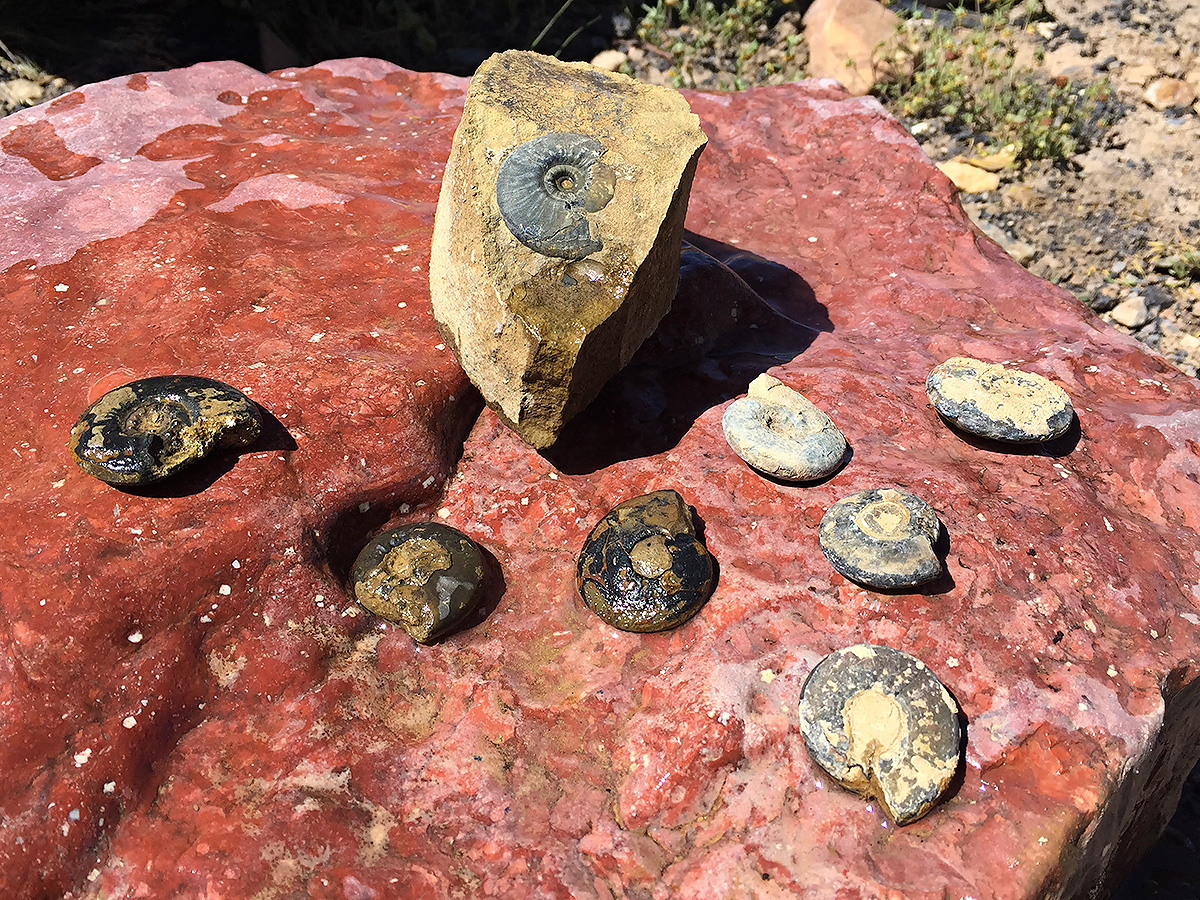
After the exciting mammalian views in the mountains and the interesting encounter with Mr. Zhou, disappointment followed in the valley. Once again, nearly every square meter was fenced off and given over to grazing. In a magnificent stretch of high-altitude steppe that not long ago held thousands of ungulates, we managed to view only 10 Tibetan Wild Ass and 38 Tibetan Gazelle—and thousands of domestic sheep.
We drove slowly into the night on the Suli-Yangkang road, still being constructed. We left this road at 37.929055, 98.385921, a point 39.6 km (24.6 mi.) north of Yangkang Xiang (37.675509, 98.635267). We drove west, toward the lake.
Rain began to fall, giving us a rare encounter with Chinese Zokor, probably flooded out of its burrow. We also saw Mongolian Five-toed Jerboa. We stopped at 37.971139, 98.085444.
STUCK IN THE BACK COUNTRY
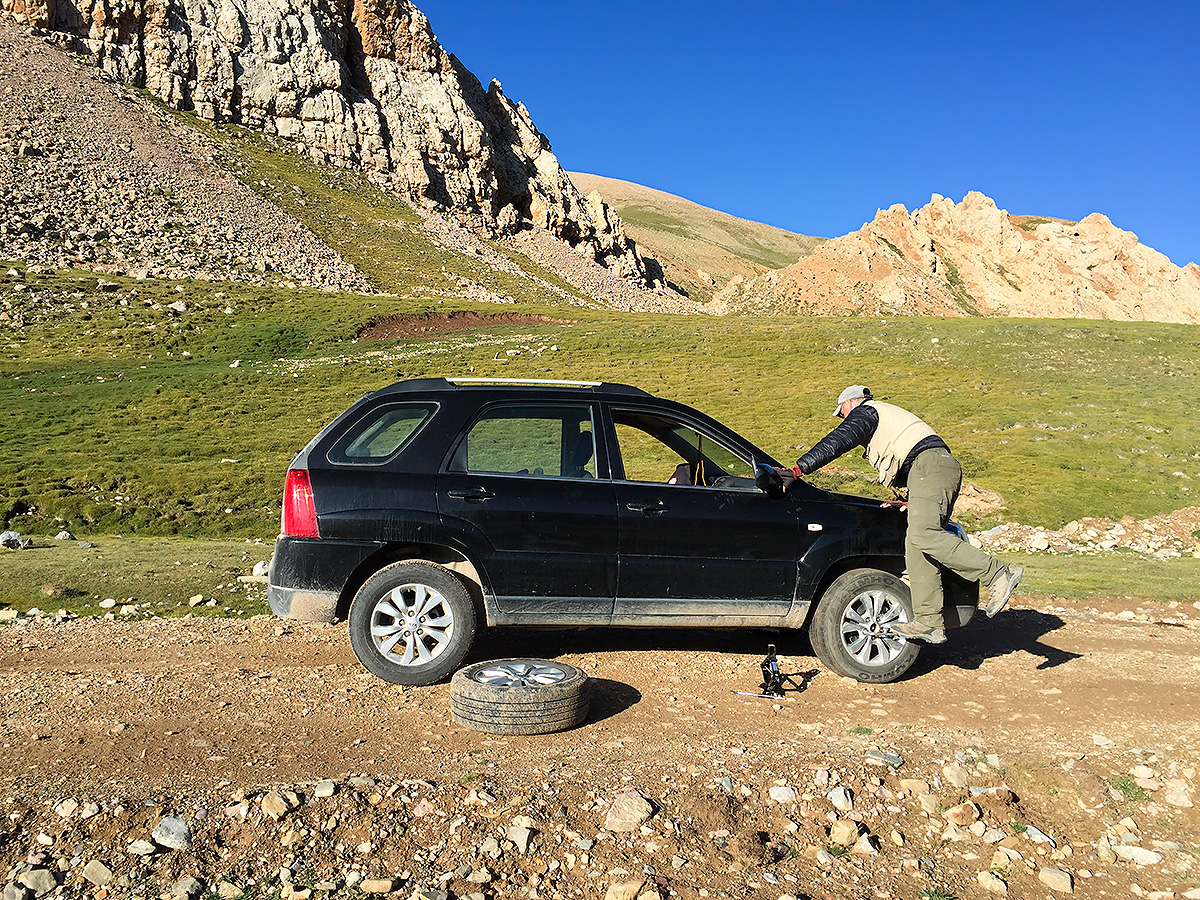
On Mon. 8 Aug. I awoke to find a flat tire on our rented Kia Sportage. A tiny nail had caused a slow leak. We were 30 km (19 mi.) away from a paved road, 40 km (25 mi.) from the lake. As I was putting on the spare, a Tibetan Snowcock called from the ridge above.
We drove the 70 km (44 mi.) back to Yangkang Xiang, the nearest place with tire-repair shops. Our tire was repaired by a Hui man who told me that he had originally tried to overcharge me because I am foreign. (The attempt to rip me off did not surprise me; the candor did.) We threw the newly repaired tire in the trunk and drove back into the wilderness.
We camped at 37.980045, 98.047005, just 3.5 km/2 mi. (and five creek crossings) from the spot from the night before. We had gone essentially nowhere in 24 hours, but we had long since factored mishaps and difficulties into the price we were willing to pay to see Hala Lake.
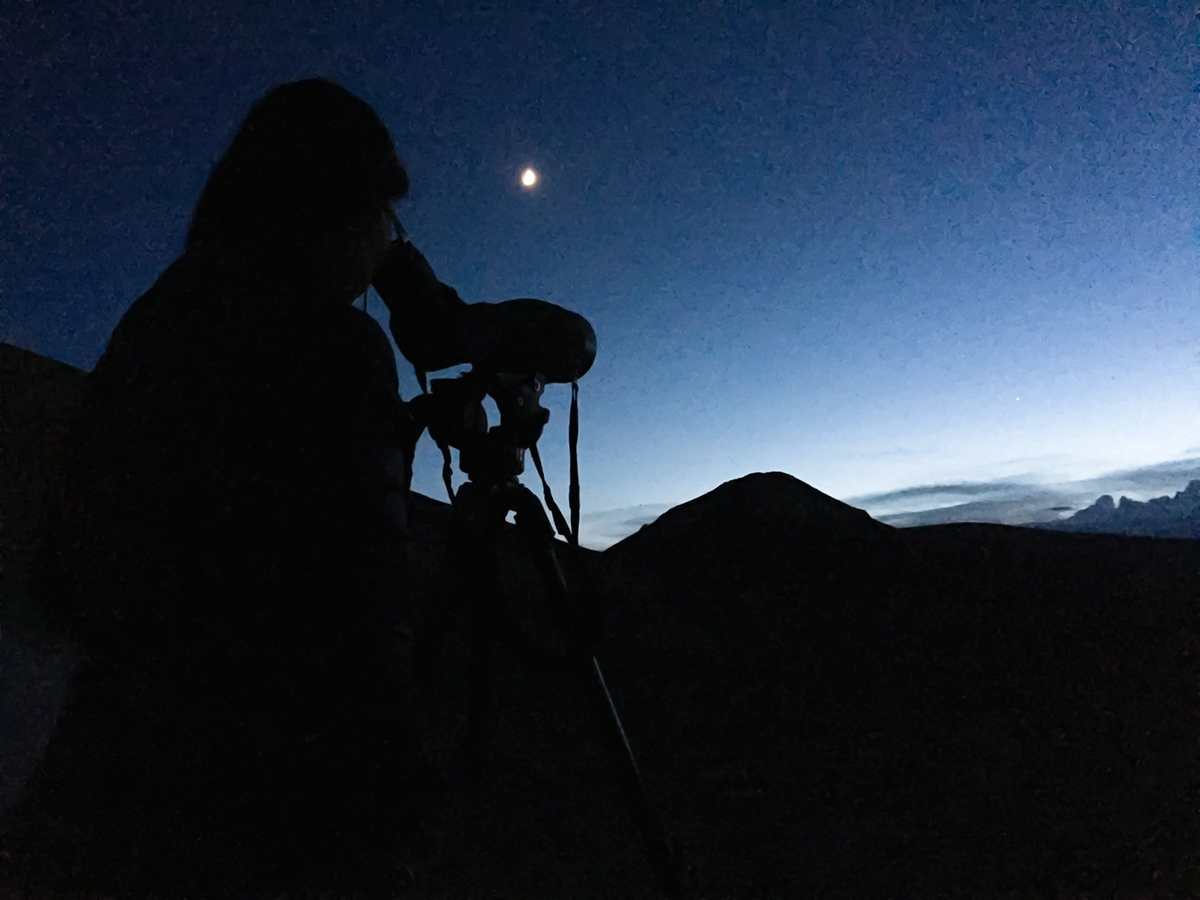
In the clean air the light from a slim crescent moon was casting shadows, and for the first time I could make out the bands of Saturn. I viewed Saturn through my Swarovski ATX-95 30-70x scope.
WE REACH HALA LAKE
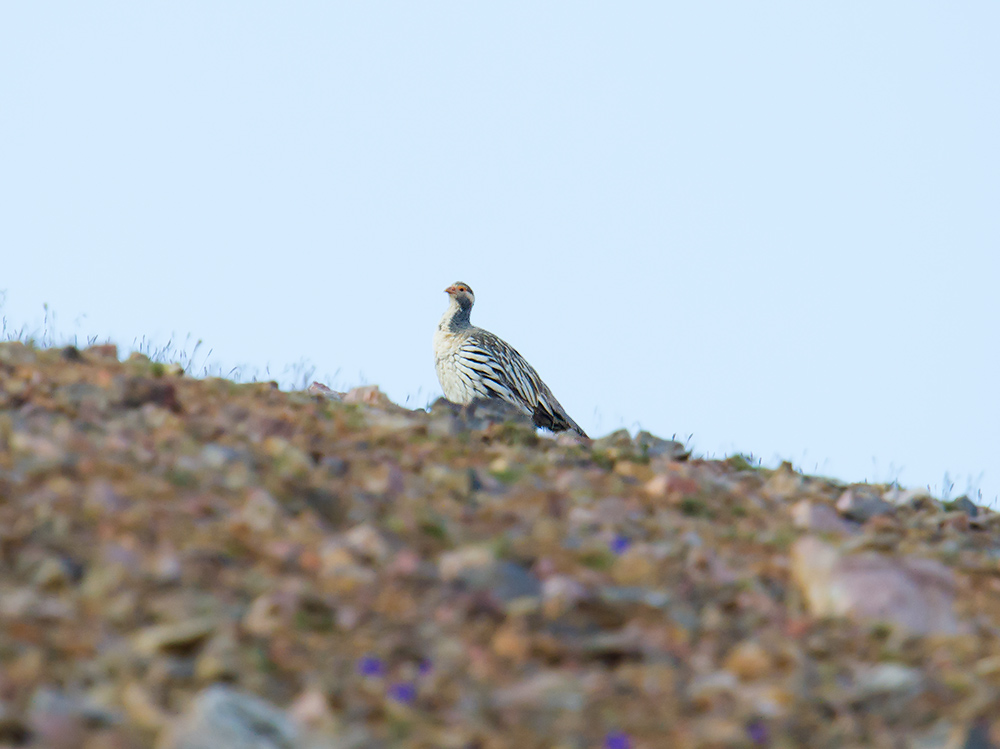
The next morning, Tues. 9 Aug., I awoke at dawn and heard, coming from the ridge above, the calls of Tibetan Snowcock. I scoped a group of seven. Carrying my camera, I climbed 300 m (980 ft.) to the ridge, elev. 4400 m (14,440 ft.). I found the snowcocks, three adults and four juveniles. I saw Brandt’s Mountain Finch, Tibetan Snowfinch, and Blanford’s Snowfinch. All were feeding young. I noted a single Plain Mountain Finch.
From the summit the valley spread out like a map before me, and I saw that the road made not just a sixth but also a seventh and eighth crossing of the creek before leaving the valley for the steppe. Those five crossings the day before had made me nervous.
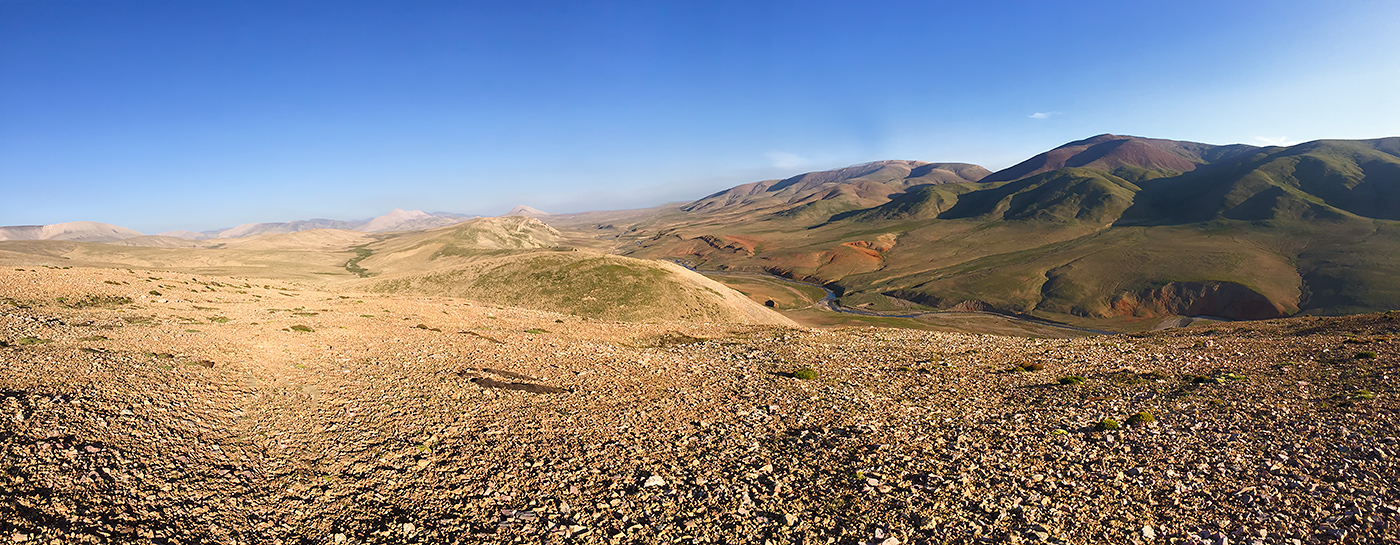
I returned to camp and met two Tibetan herdsmen. One could just barely speak Chinese, and he told us that it is possible to circumvent the sixth and seventh crossings. Yet another Tibetan arrived, Rén Qīng Cái Ràng (仁青才让). Rén Qīng was younger than the other two and spoke good Chinese. Rén Qīng watched us as we drove along the bluff above crossings 6 and 7 and descended safely to the road. The eighth crossing was a piece of cake. (Our 2WD Kia Sportage was a fine mini-SUV, but in the Hala Lake back country I would have felt safer in a larger 4WD. It would also be better to have at least one other vehicle in the group to serve as a rescue car.)
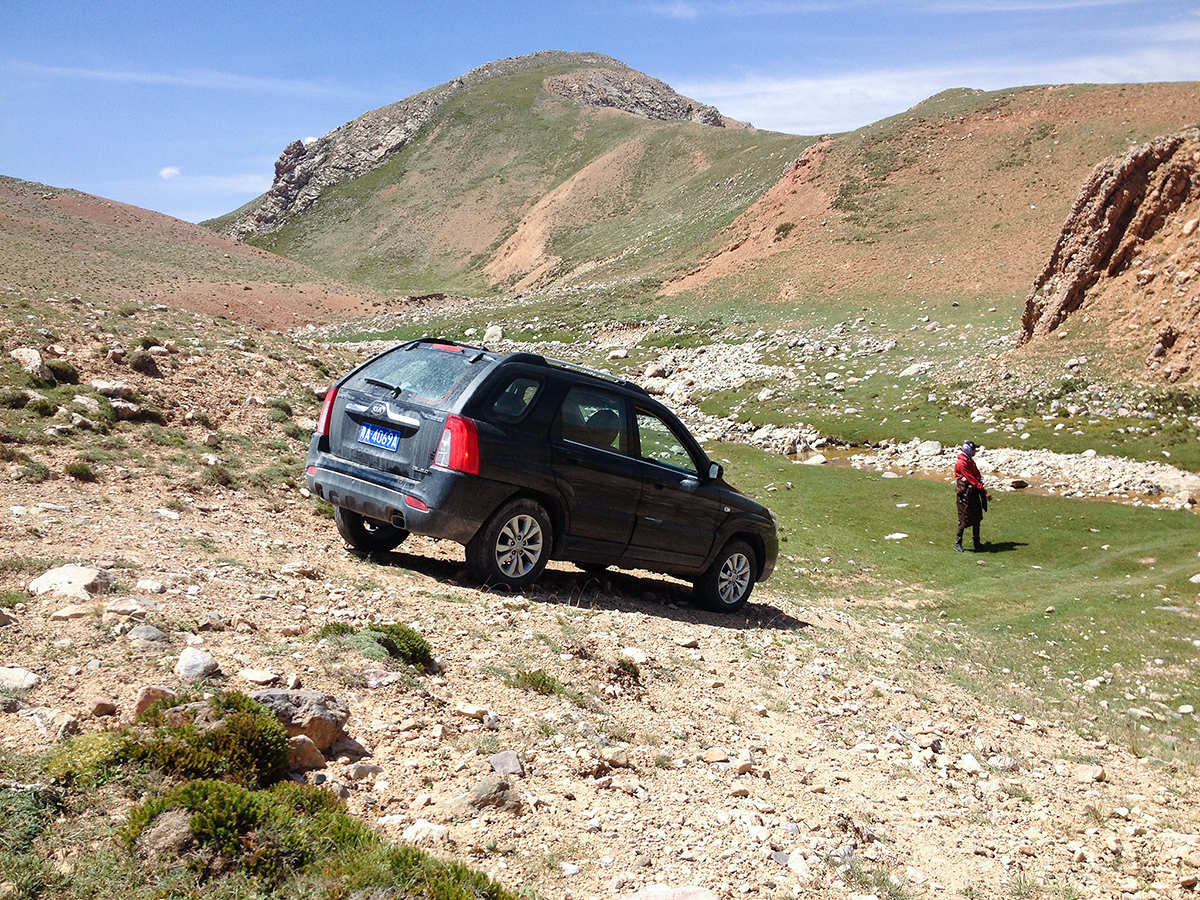
On the steppe Elaine and I witnessed scenes unlike any we have encountered in China. The valley spread out endlessly before us, with the snow-capped South Shule Mountains in the background. All was stillness and silence. There are scenes nearly as thrilling on the G214 in Guoluo and Yushu prefectures, but one views those landscapes from a busy highway, not from an unpaved road in the middle of nowhere. We met just one person on the steppe, a Tibetan herdsman on horseback who asked us to take him to Yangkang Xiang.
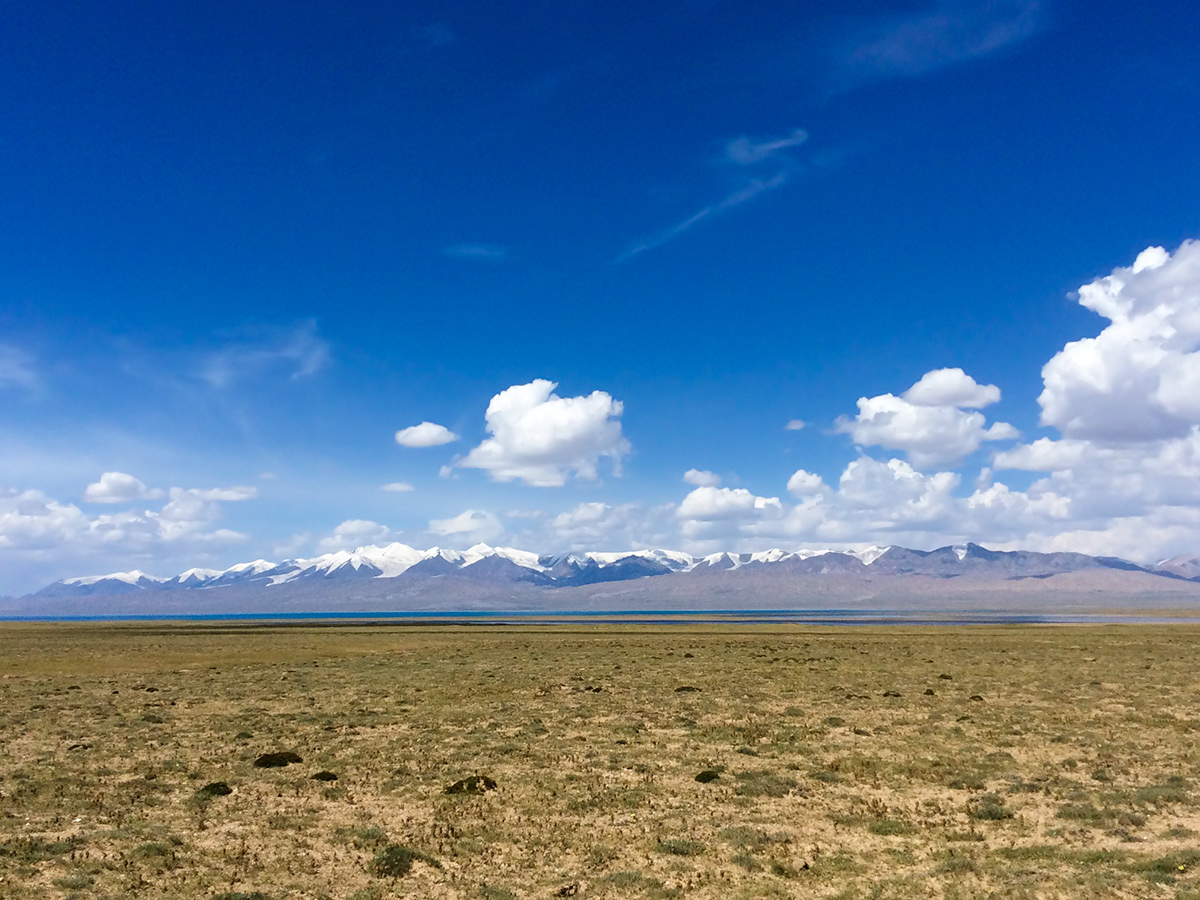
After driving about 30 km (19 mi.) we saw a turquoise glow on the horizon: Hala Lake. The second-largest lake in Qinghai, the inland sea covers an area of 607 sq. km (234 sq mi.). Here at the eastern end of the lake one gets one’s closest views of the father of the waters, the mighty Gangze Wujie, elev. 5808 m (19,055 ft.). That awe-inspiring peak and its siblings north of the lake are complemented by other peaks on all sides, a dramatic reminder that the water here at elev. 4077 m (13,376 ft.) has no outlet. The azure sea with snowy peaks behind is a deeply impressive sight. Except for the wind, all is silent; except for a few Tibetan herders’ tents in the distance, not a soul is around. The only signs of man are the road and the hundreds of sheep and yaks dotting the slopes.
Almost as soon as we arrived, the wind picked up, and rain started to fall. (Rain, it turned out, would bedevil us every day at Hala.) We noted species common to the high steppe, among them Tibetan Gazelle, Lesser Sand Plover, Horned Lark, and Rufous-necked Snowfinch. We turned the Sportage into our bedroom and spent the night on a bluff above the lake.
TIBETAN SANDGROUSE!
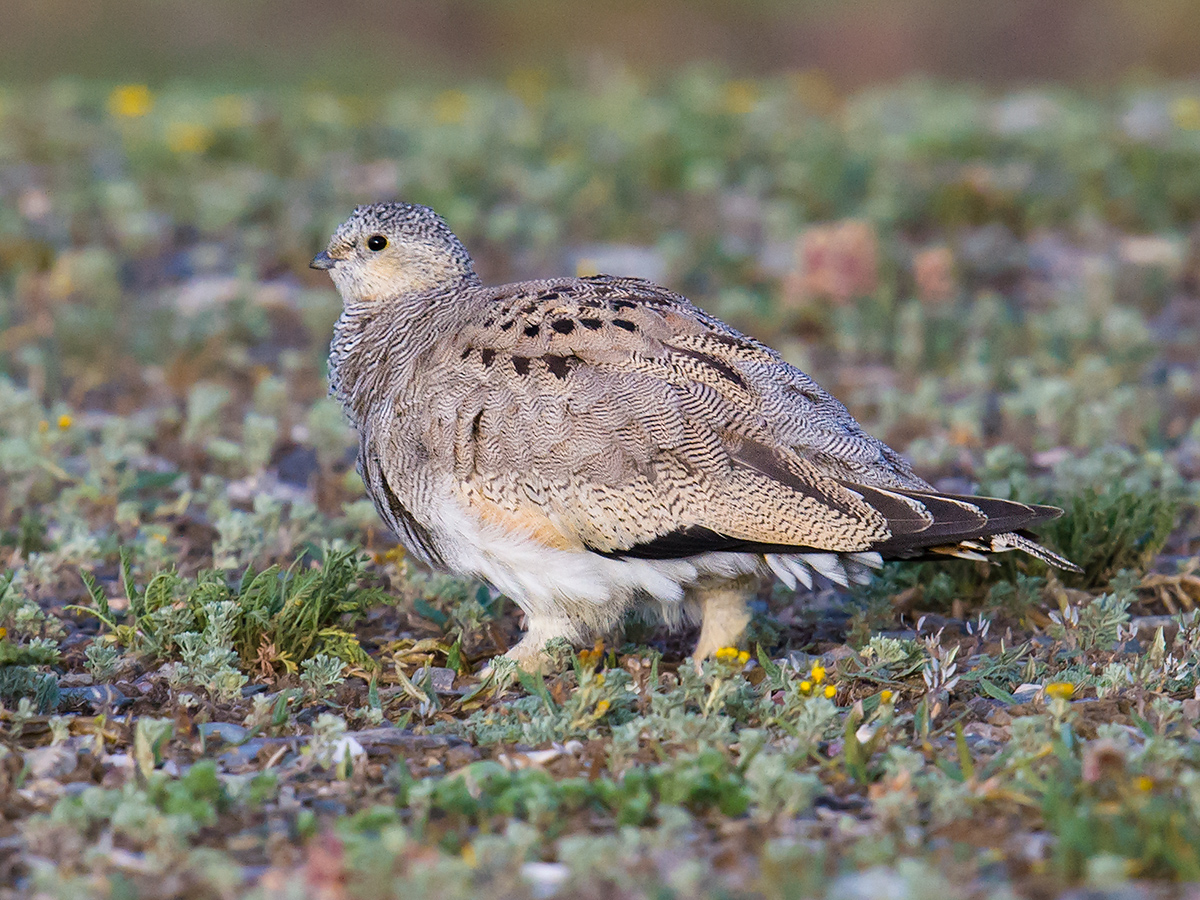
The next day, Wed. 10 Aug., the rain was less but the wind even fiercer, blowing gale-force across the lake. We drove off the elevated unpaved road toward the lake, parking well away from the soft sand fringing the inland sea. We walked a few hundred meters to the shingly shoreline, there finding 2 Ruddy Turnstone. Hume’s Short-toed Lark were calling, and there were juveniles around. Interestingly, we were finding Hume’s Short-toed only on the shore and about 300 m inland. The larks act like stints, running frantically along the shore, picking up insects. We saw 3 Pallas’s Gull, 6 Bar-headed Goose, and 1 each of Little Ringed Plover, Common Redshank, and Brown-headed Gull.
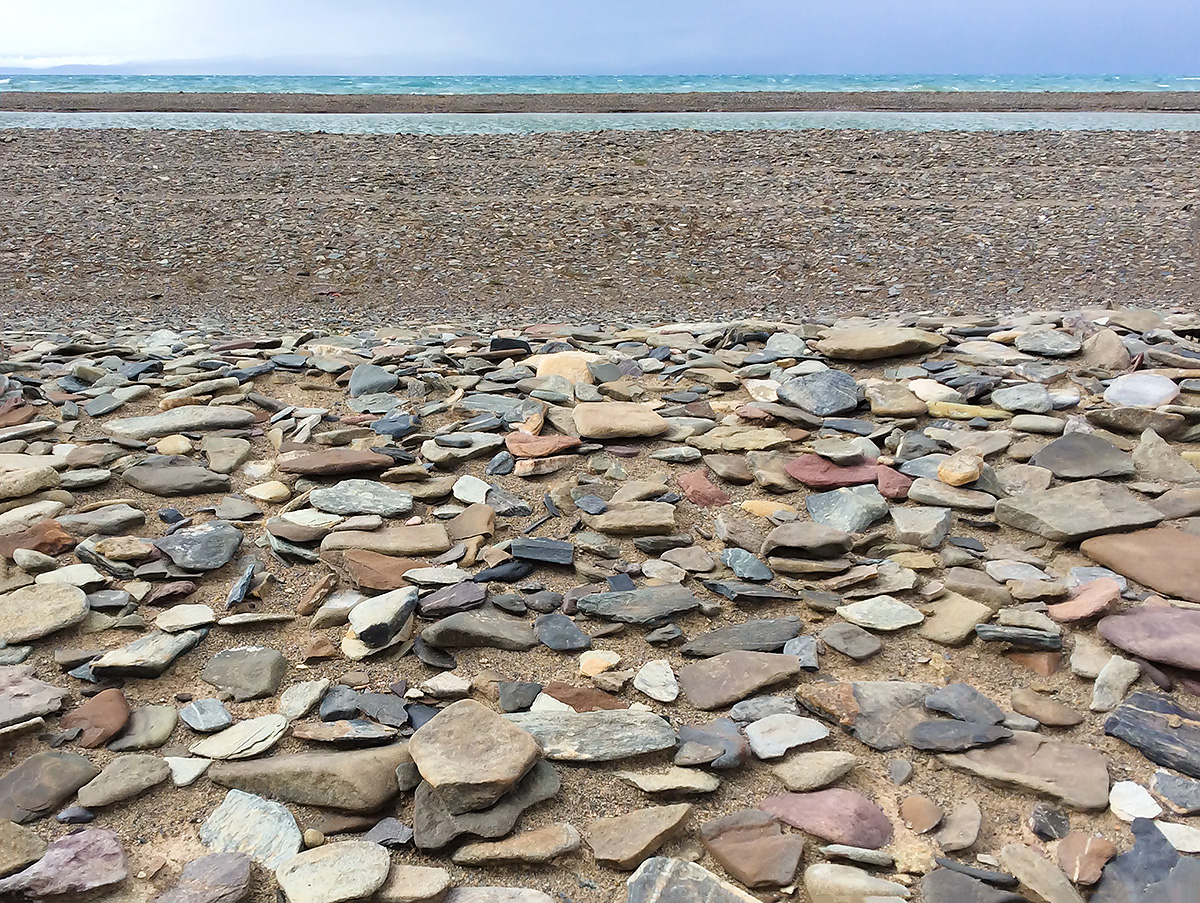
We could stand the gale no longer; we walked back to the Sportage, on the way noting Rufous-necked Snowfinch. Back on the road, driving west across the steppe, we saw a Ruddy Shelduck foraging on the track, a Saker Falcon, 7 Eurasian Hoopoe, and 2 Isabelline Wheatear.
We made half a dozen more non-dangerous stream crossings in the Sportage before arriving at Menggu Bao, the most developed place on Hala Lake. Here, yurts await tourists who have braved the three and a half hour ride north from Hedong-Hexi—or in our case, the even longer easterly route from Yangkang Xiang. Treasuring our self-sufficiency, we bypassed the outpost and continued west. (This was a good move, as we almost surely would have been reported the moment we set foot in the lobby.)
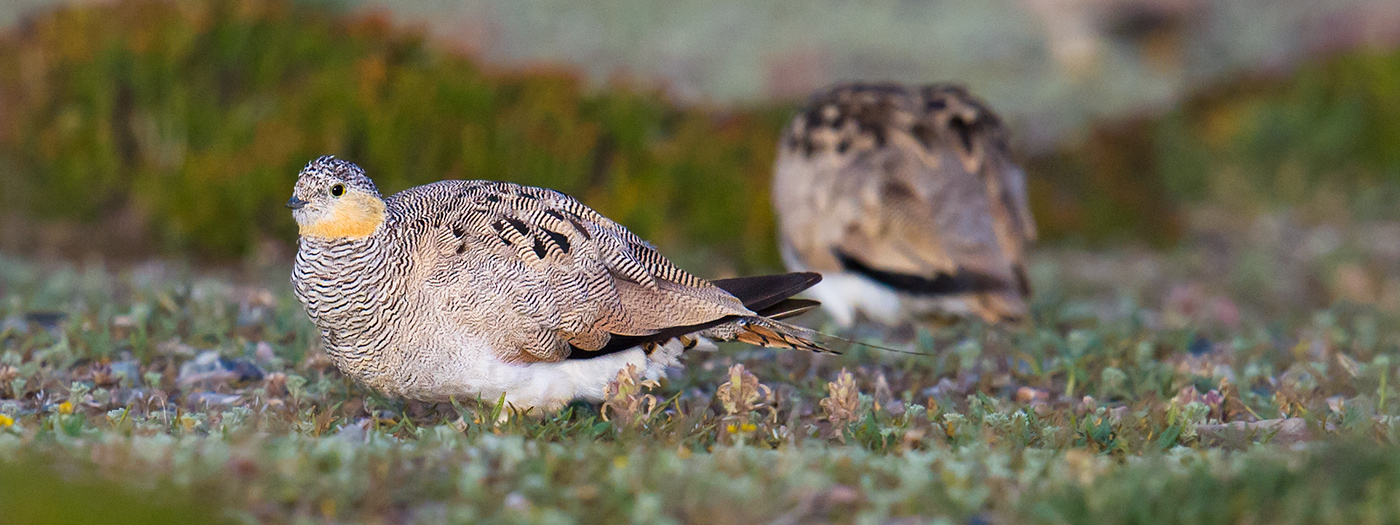
Driving slowly on a muddy, non-elevated dirt track, Elaine and I found a flock of 21 Tibetan Sandgrouse, a life bird for us both. We were at 38.205017, 97.520042. The extremely flat terrain, just a few meters higher than the lake, must be good habitat for sandgrouse, as we found another 32 in flocks, trios, and pairs. Juveniles were among the sandgrouse we counted; surely the species breeds in the area.
We drove ever west, the nearly perfectly flat terrain broken only by the slightest of depressions, in which were puddles, ponds, and occasionally running water. We found a slight rise of dry, sandy soil and there pitched our tent. The point is 38.209028, 97.477056 and would be our home for the next three nights.
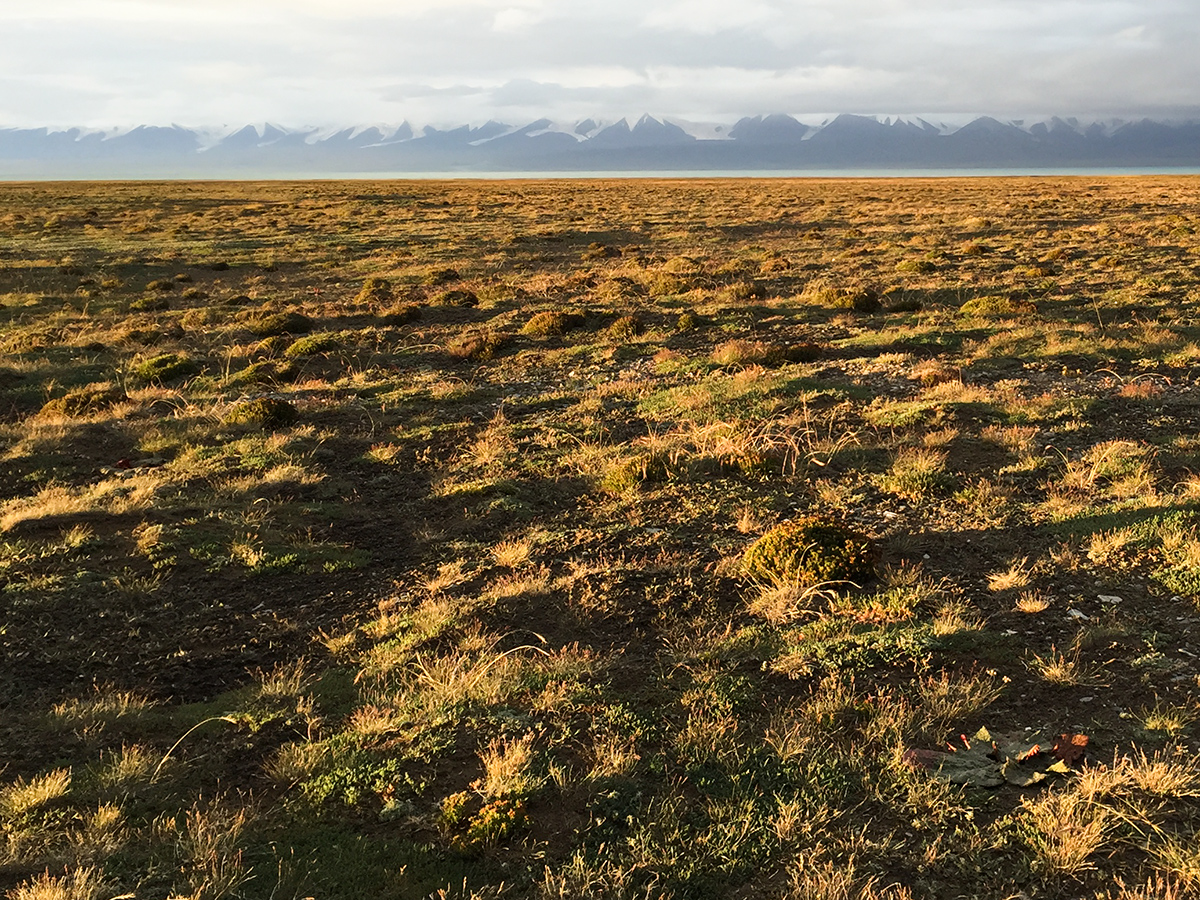
In wetter ages our camp surely was lake bed; though we were 500 m (1,600 ft.) from the shore, our elevation could not have been more than 5 m (16 ft.) higher. A few hundred meters west of our camp is the largest stream in this southwestern sector of Hala Lake. The stream is the deepest drivers must cross on the remote mountain road linking Hala Lake and Subei, Gansu, 320 km (199 mi.) from our camp.
RAIN …
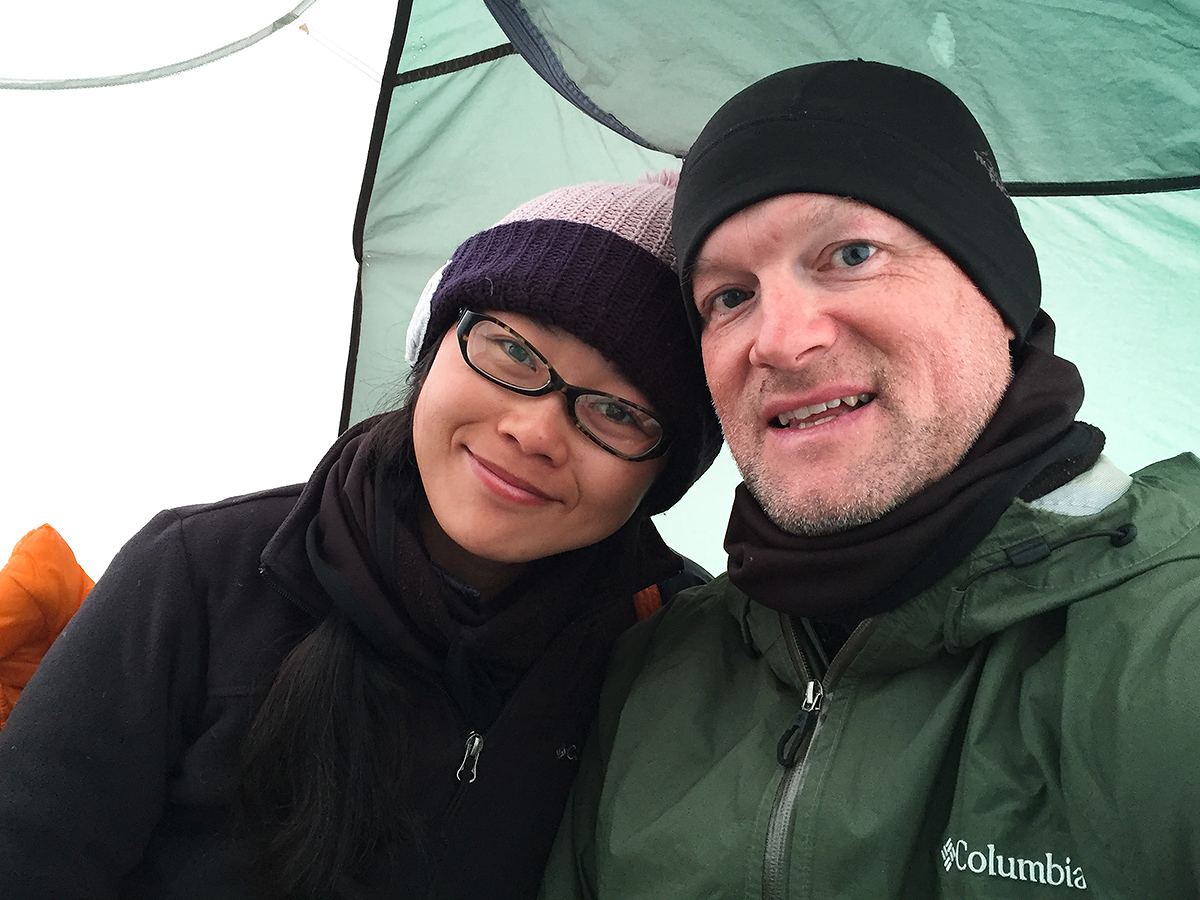
On Thurs. 11 Aug. rain fell all day. We used the time to rest in our tent. Even after seven weeks in Qinghai, we still were not fully accustomed to the high altitude. Long drives, long walks, and intensive birding tax one much more at elev. 4000 m (13,120 ft.) than at lower elevations.
The camp became our little world. Because we had set our tent on higher, sandier soil, and because I dug a little ditch on the periphery, the floor stayed dry. To block the wind blowing off the lake, I parked our Sportage close to the north side of the tent. We ate freeze-dried beef stew from Mountain House, the same brand I used while hiking the Grand Canyon in the 1980s. In the morning, when it was only drizzling, I took a bath using creek water we collected in empty Nongfu Spring bottles. Earlier in the trip, Elaine and I invested 20 yuan in a shovel, and with it I had dug a latrine. Elaine and I were clean, dry, and well-fed in our neat little camp in the wilderness.
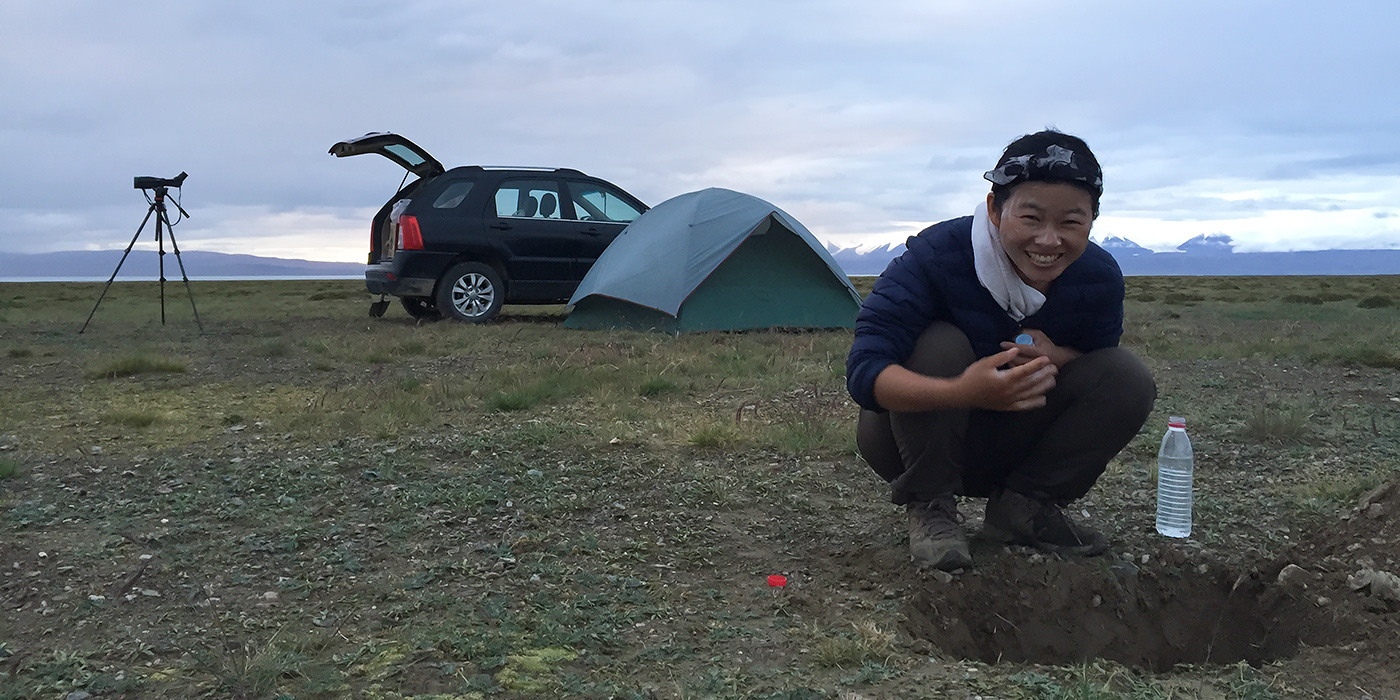
During a break in the rain, I emerged and set my Swarovski scope atop my Manfrotto tripod and head. My 360-degree scan of the vast plain and lake took a full hour. From a distance of about 2000 meters/yards, I watched a Tibetan Fox dig up and devour a pika. I counted 8 Eurasian Hoopoe, one of which flew into our camp; watched a flying Northern Raven scrutinize our camp; and admired the snow-clad peaks north of the lake.
LITTLE STINT AT HALA LAKE
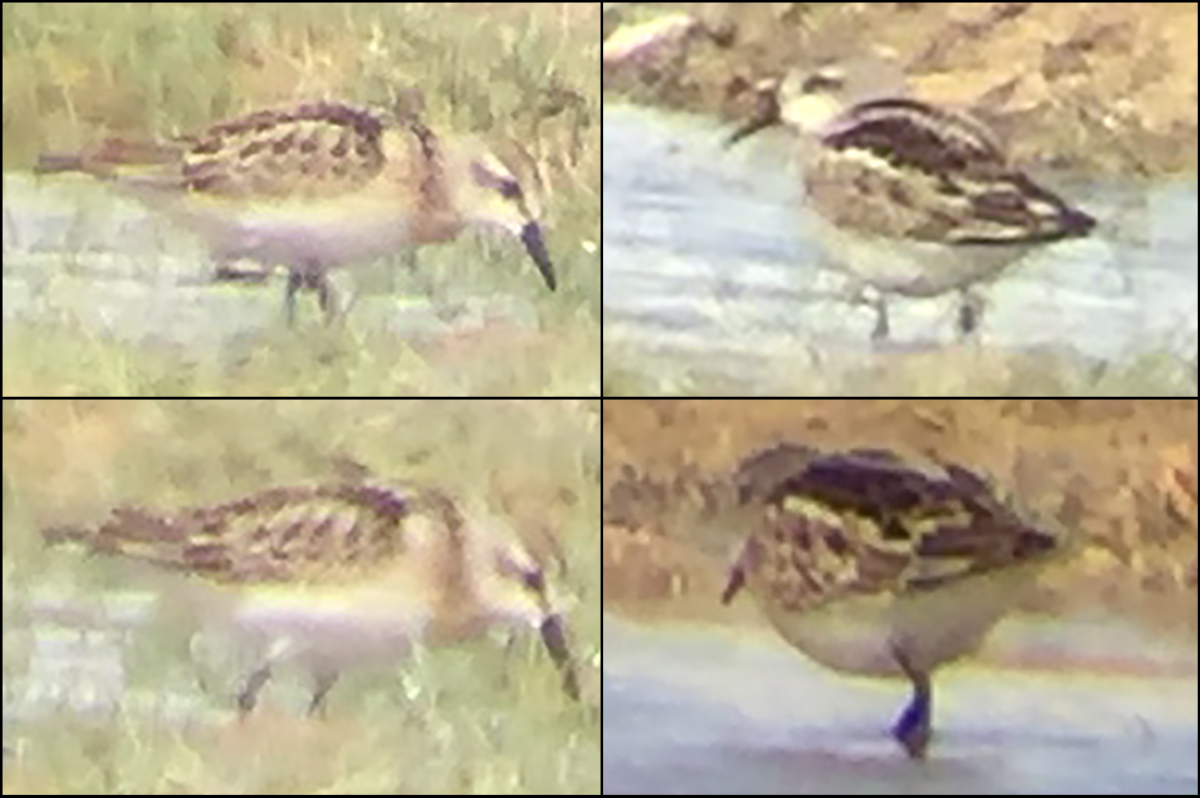
On Fri. 12 Aug., the rain let up, and Elaine and I added eight new species to our trip list. We birded the southwest corner of Hala Lake, including the big stream that empties into the inland sea. Among the new additions were good Qinghai records Little Stint, Curlew Sandpiper, Ferruginous Duck, Eurasian Whimbrel, and Temminck’s Stint as well as Mallard, Grey Plover, and Common Greenshank. We once again recorded Ruddy Turnstone, we added to our Hala list Common Merganser, Common Shelduck, and Black Stork, and we had appreciable numbers of Ruddy Shelduck (85), Bar-headed Goose (80), and Lesser Sand Plover (230). We noted 29 species in all.
The brown on the Little Stint was so impressive that my first thought was not Red-necked Stint—I have never seen so dark a Red-necked Stint—but Broad-billed Sandpiper. The bird however was showing typical stint characteristics such as high pecking rate, constant, quick movements, and small size. I moved in closer, noting the bill, which was blunt-tipped, not downward-kinked, as in Broad-billed Sandpiper. The bill attracted my attention in another way: It was longer than the bill of a typical Red-necked Stint. I noted prominent white stripes on the brown mantle, a pale forehead, and very dark brown stripes on the crown. The flight feathers lacked grey coloring. Everything added up to juvenile Little Stint.
The 3 Curlew Sandpiper were in the delta of the big southwest stream and were easily ID’d. Two were juveniles with peach wash across the breast, and one was an adult molting into winter plumage.
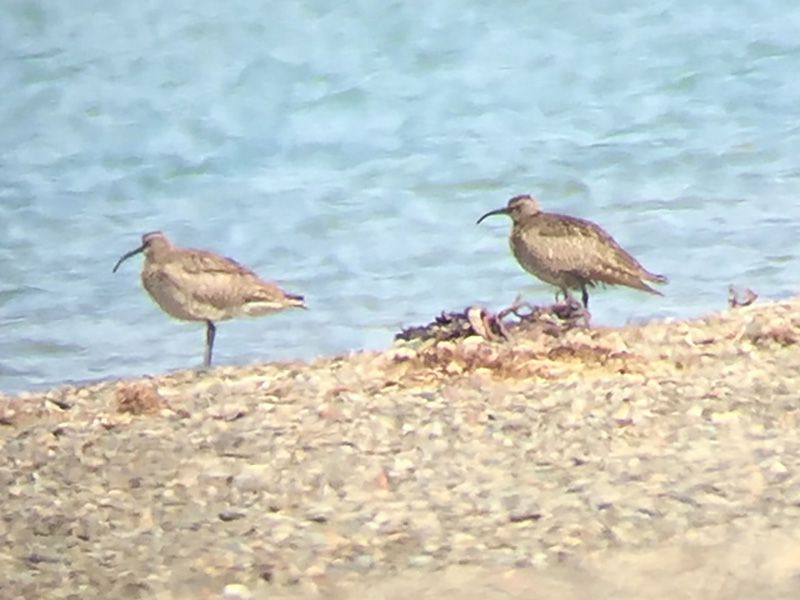
The 2 Eurasian Whimbrel were on the lakeshore, the Grey Plover and Common Greenshank in the delta. The 2 Mallard were males in eclipse plumage and were in the delta. Temminck’s Stint and Ferruginous Duck were in the delta and on the lakeshore. Ferruginous Duck showed very dark plumage, white undertail, and peaked head with no hint of tuft.
We met Andreas Bruder, a bicyclist from Dresden, Germany who had started his journey in Dunhuang, Gansu. He had cycled to Subei, ridden in a pickup truck to a point near the gate of Lanchiwang Nature Reserve, somehow slipped in, and continued on into the Hala Lake basin. (Later, near Menggu Bao, Andreas would be arrested for being in Delingha County.)
The grey sky finally blued up, but in the afternoon rain fell once again, this time in a squall. Elaine and I ran to the Kia Sportage, which I parked in an east-west orientation. So hard was the wind off the lake that I could open the south-facing windows, and nary a drop of rain fell in.
On Sat. 13 Aug., rain once again fell most of the day. We birded the lake, adding Pied Avocet to our Hala list. We decided we could not stand another night in the rain at high altitude. As darkness fell, we drove east, toward Menggu Bao, again noting Tibetan Sandgrouse at 38.205028, 97.520028.
We drove the Delingha road south in the dark and began our exodus from Delingha County.
PHOTOS
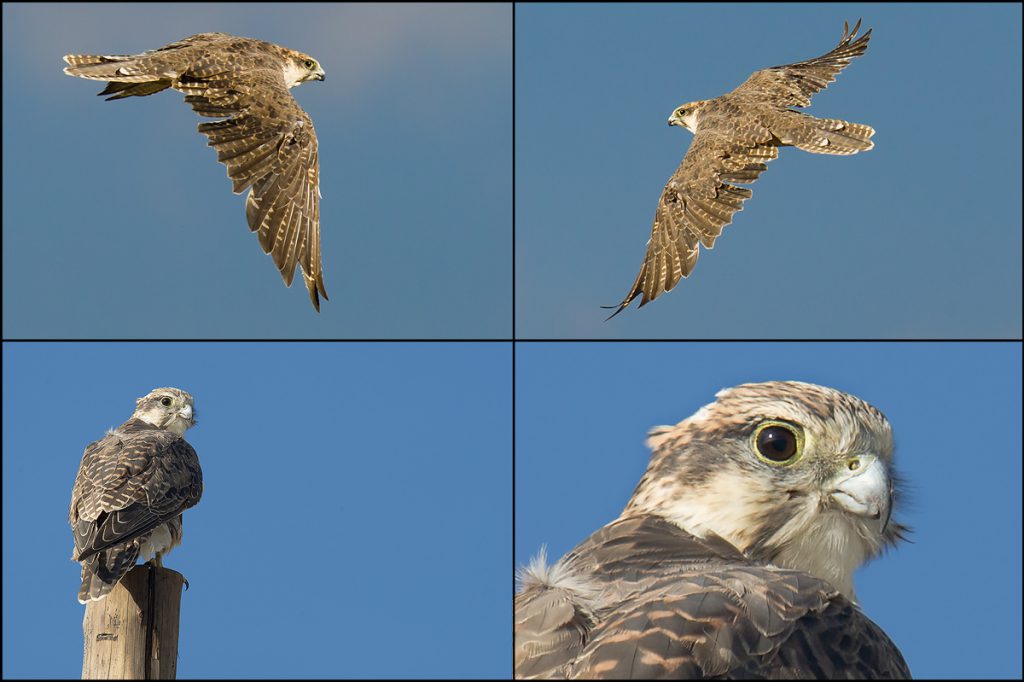
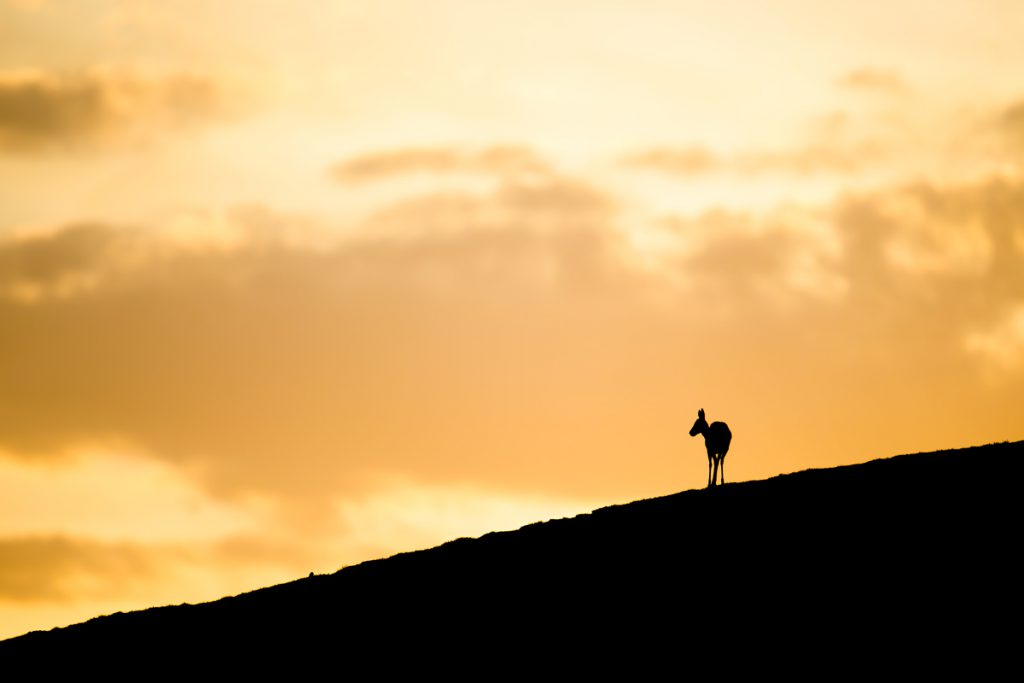
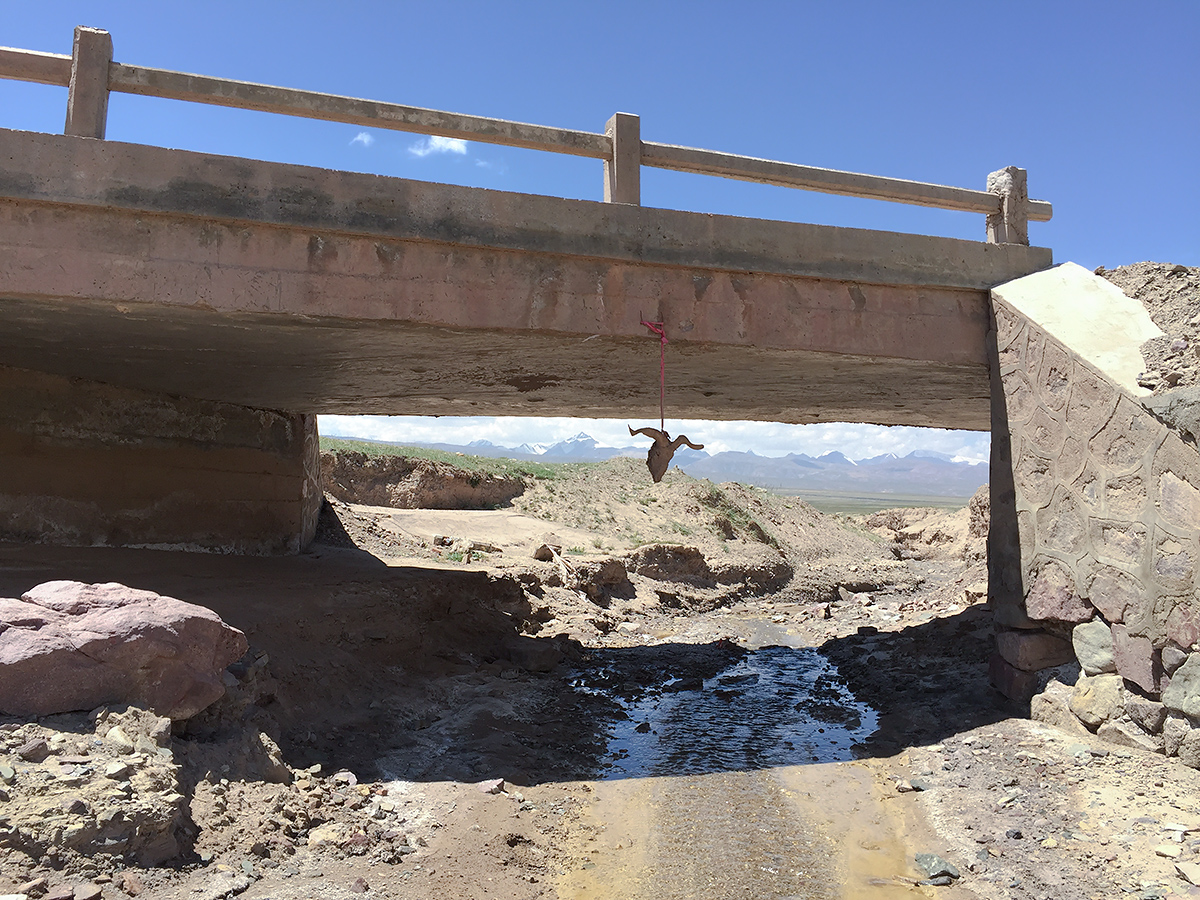
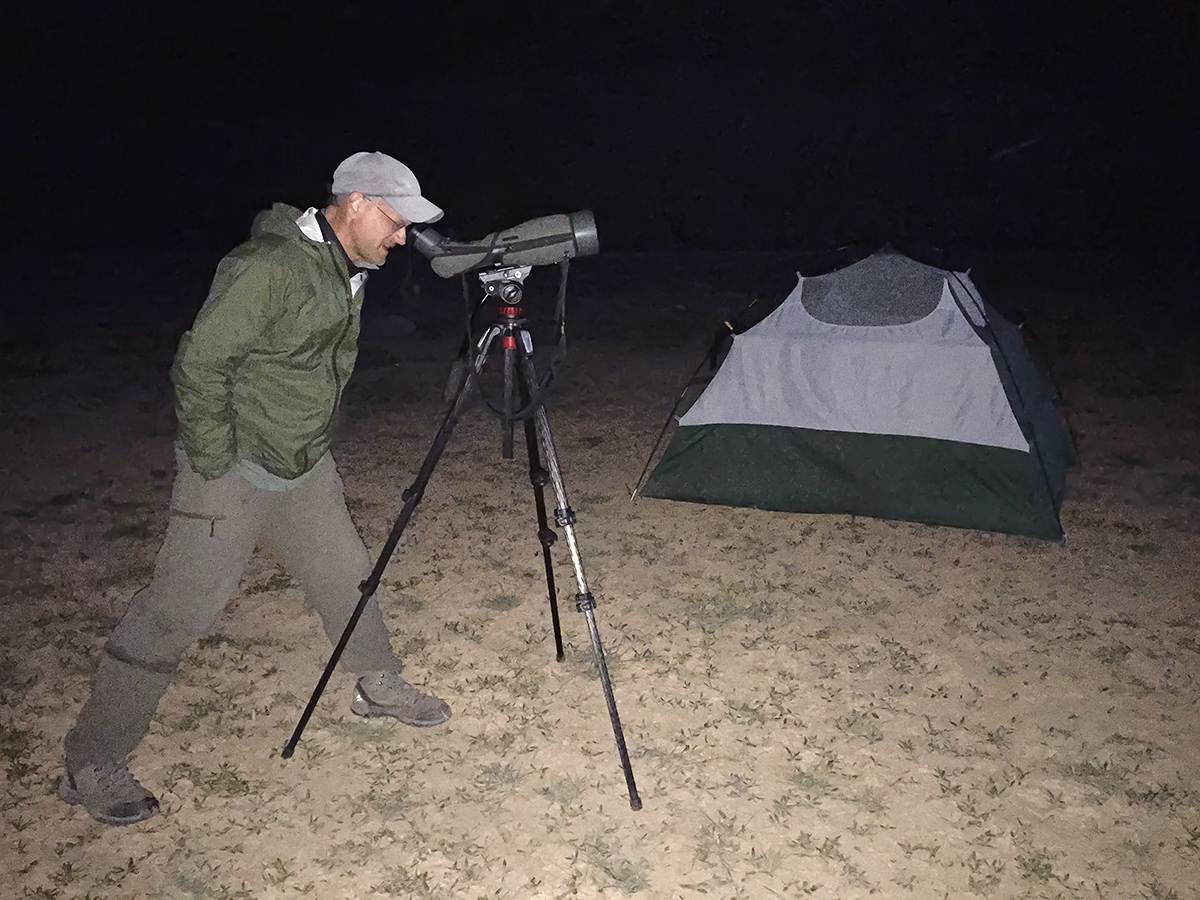
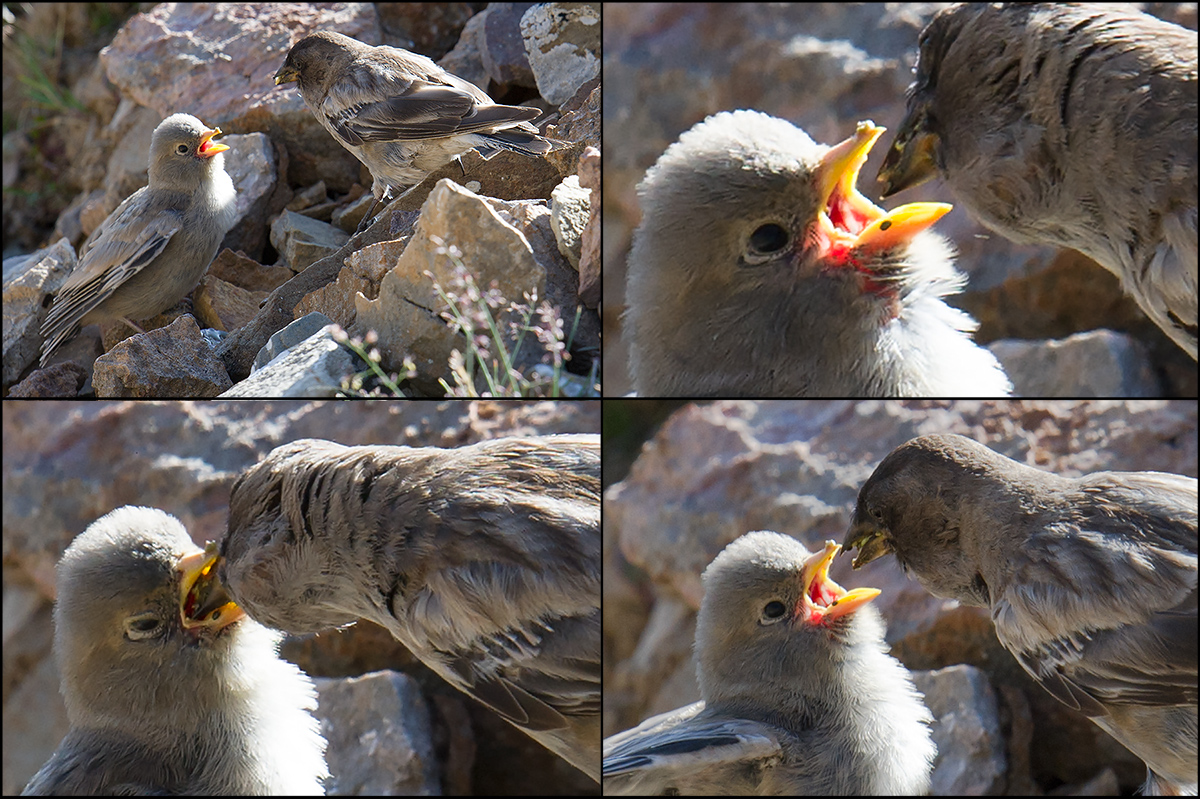
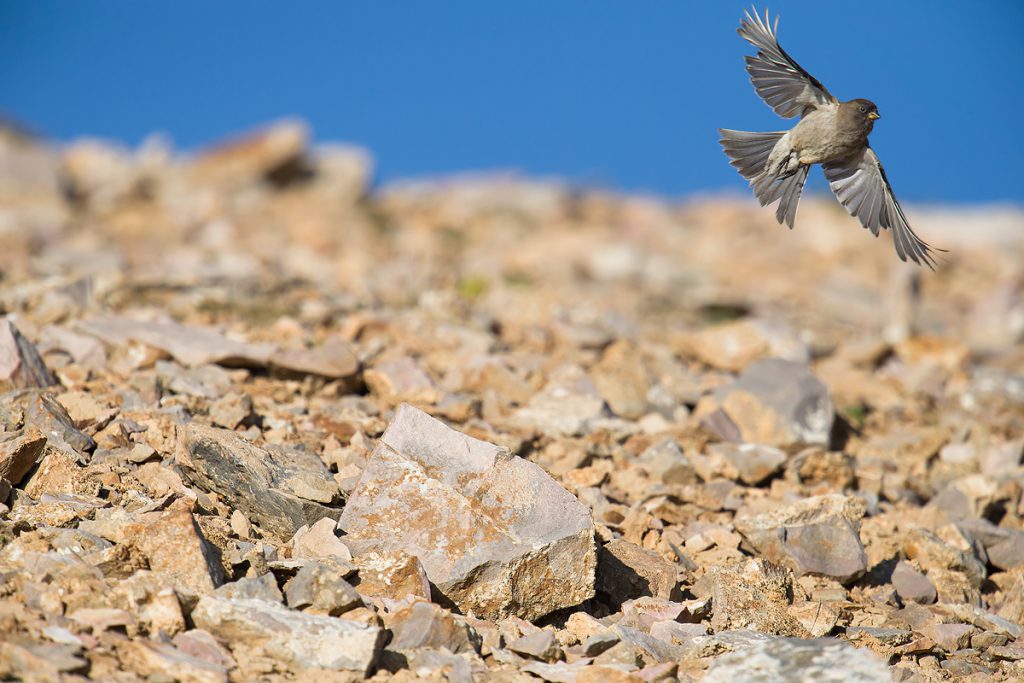
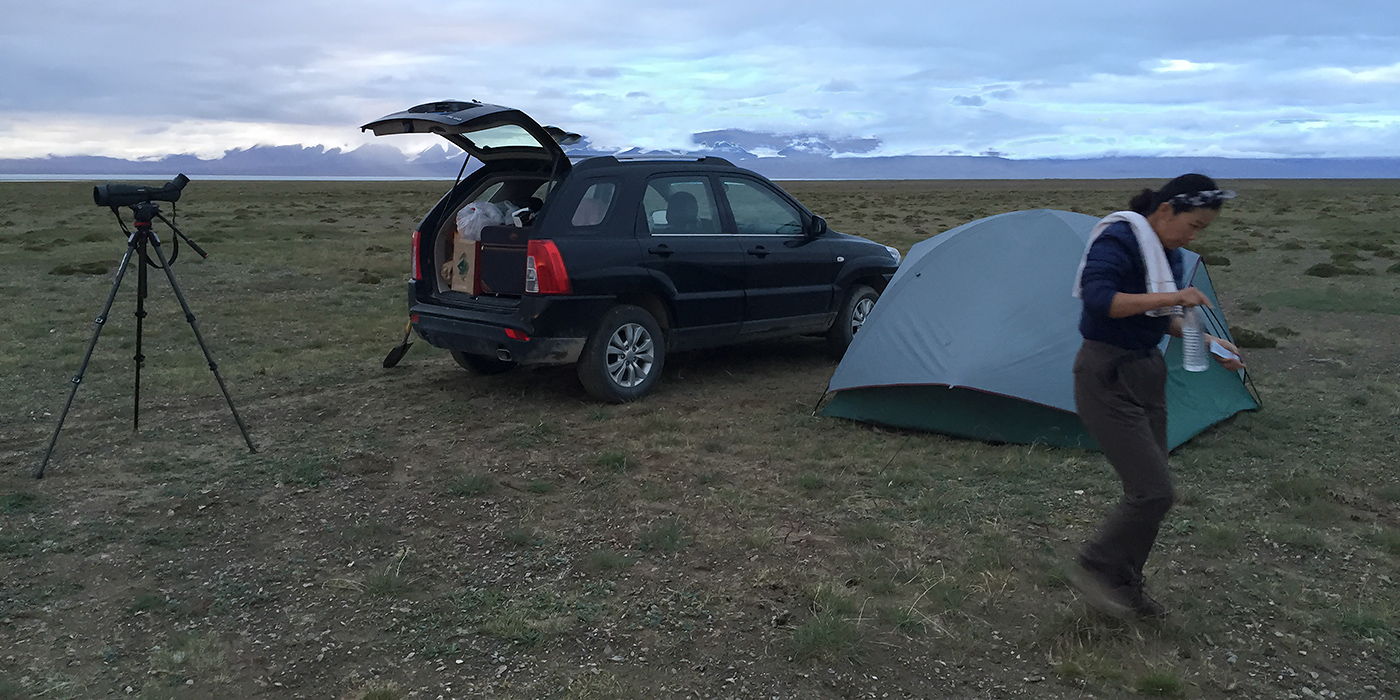
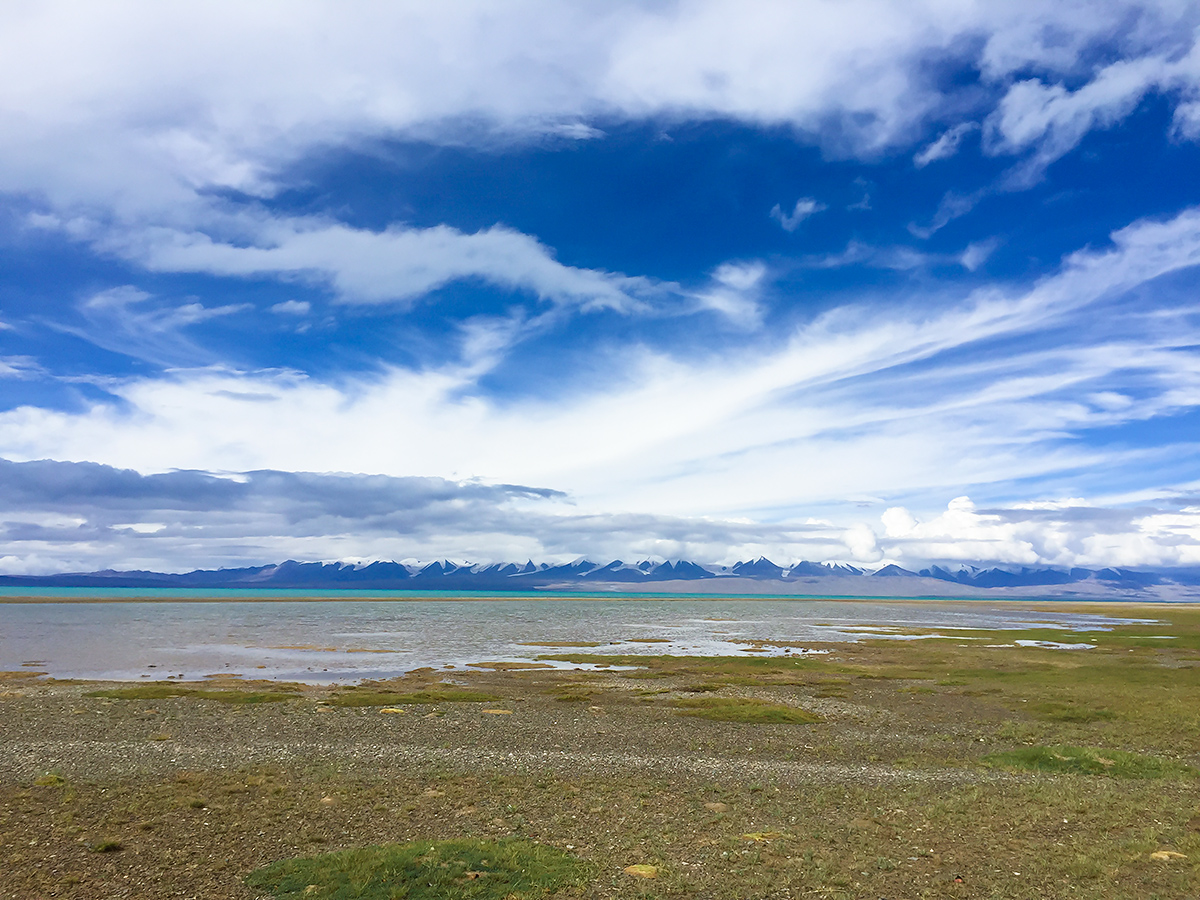
INDEX
shanghaibirding.com offers unparalleled coverage of birding in Qinghai. Below is an index to our posts on Qinghai. Reach us at info@shanghaibirding.com.
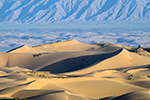
Summer-long Birding Expedition to Qinghai (Introduction): We birded Qinghai from June to August, spending the entire summer in the province. We noted classic Tibetan Plateau birds White Eared Pheasant, Black-necked Crane, White-browed Tit, and Przevalski’s Redstart. We explored little-birded northern Qinghai, discovering new locations for Przevalski’s Partridge, Tibetan Sandgrouse, and Gansu Leaf Warbler.
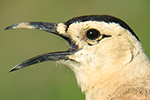
Birding Eastern Qinghai, from the Border with Gansu to the Border with Tibet: We spent the first two weeks of the expedition covering eastern Qinghai, from the Gansu border in northeast Qinghai to Ga’er Monastery on the border with Tibet. We had Henderson’s Ground Jay west of Chaka, Ibisbill on tributaries of the Mekong River, White-browed Tit in scrub along the G109, and Güldenstädt’s Redstart breeding near Qinghai Lake.
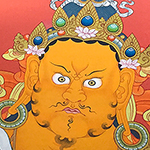
Birding Qinghai’s Eastern Yushu Prefecture: We found Tibetan Lynx in the Kanda Mountains, discovered new birding sites, and at an art school in the wilderness immersed ourselves in Tibetan Buddhist culture. Among our highlights were Grandala and Red-fronted Rosefinch, the highest-breeding bird in the Palearctic. Our mammals included White-lipped Deer and Mongolian Five-toed Jerboa, and we saw evidence of attacks by Brown Bear.
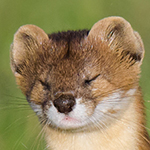
Birding the Qilian Mountains of Northern Qinghai: Our most important discovery was the poplar forests along the Heihe and Babao rivers, where we encountered woodland species Gansu Leaf Warbler and Chinese Thrush. Conifer forests yielded Black Woodpecker, and the scrub and pastureland gave us Eurasian Eagle-Owl, Siberian Roe Deer, and Mountain Weasel.
Forbidding (and Forbidden) Hala Lake (you are here)
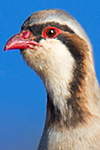
Birding the Remote Backcountry of Wulan County, Qinghai: Amid stunning scenery, we found Tibetan Wolf, discovered a new location for Przevalski’s Partridge, and around Lake Xiligou had Qinghai favorites Black-necked Crane and Tibetan Lark. The lake held a noisy super-flock of 4,600 Ruddy Shelduck, and Mongolian Goitered Gazelle were in the hills behind. Near Chaka we had Mute Swan.
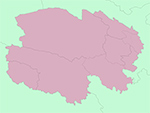
Index to Place Names in Qinghai: Study this list and plan your trip to Qinghai, the most exciting province for birding in China. We offer fascinating facts on famous places as well as sites little known, all with geographic coordinates. Read also our bibliography and use our index of eBird lists from the summer-long expedition.
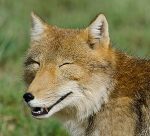
Mammals and Birds of the Tibetan Plateau: Our team drove 3977 km (2,471 mi.) in 15 days, starting and ending in Golmud, Qinghai. In mountains as high as 5100 m (16,730 ft.), we found 98 species of bird. Mammals were the big stars. I watched a Tibetan Fox catch and devour a vole, we found 46 Tibetan Antelope and a Tibetan Wolf in Antelope Valley, and we saw dozens of Tibetan Wild Ass.
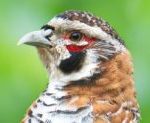
Tibetan Bunting Leads Parade of Tibetan Plateau Endemics in Qinghai: shanghaibirding.com founder Craig Brelsford led a three-person team on a 23-day trip to Qinghai. We covered most of the Tibetans (Tibetan Snowcock, Tibetan Partridge, Tibetan Babax, Tibetan Rosefinch, and Tibetan Bunting) and found Przevalski’s Finch near Qinghai Lake.
Qinghai in October: Jesper Hornskov and his team noted 178 species of bird in October, a time of year, Hornskov writes, “when few dedicated birdwatchers visit this unique land.”
Qinghai in the Age of Covid: Covid-19 complicated the trip, but watching Tibetan Wolf pups frolic made all the trouble worthwhile. We sampled a wide array of western China birds, among them Daurian Partridge, Pallas’s Sandgrouse, and White-winged Grosbeak.
In addition to coverage of Qinghai and our core area of Shanghai, shanghaibirding.com has extensive coverage of other areas of China, among them
Fujian
Northeast China
Sichuan
Xinjiang
Yunnan
Featured image: Hala Lake highlights. Clockwise from top left: glacier and mountain, Tibetan Sandgrouse, Tibetan Gazelle, and sea mollusk 50 million years old. (Craig Brelsford)

